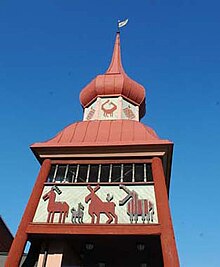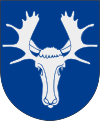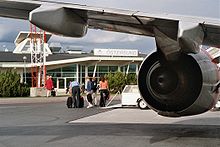Ostersund
| Ostersund | ||||
|
||||
| State : | Sweden | |||
| Province (län): | Jämtland County | |||
| Historical Province (landskap): | Jämtland | |||
|
Municipalities : |
Ostersund Krokom |
|||
| Coordinates : | 63 ° 11 ' N , 14 ° 38' E | |||
| SCB code : | 8044 | |||
| Status: | Crime scene | |||
| Residents : | 49,806 (December 31, 2015) | |||
| Area : | 34.84 km² | |||
| Population density : | 1430 inhabitants / km² | |||
| Postal code : | 831 00 - 839 89 | |||
| List of perpetrators in Jämtland County | ||||
Östersund ( ; South Sami : Staare for "the big city" or outdated: Luvlieluspie ) is a city with almost 50,000 inhabitants (2015) in the Swedish province of Jämtland County and the historic province of Jämtland .
The city is located roughly in the middle of Sweden on Lake Storsjön and is the seat of the province and capital of the municipality of the same name . A small part of the city with 790 inhabitants on an area of 93 hectares (2015) belongs to the northern neighboring municipality of Krokom .


history
Until 1500
On the island of Frösön off the town, there is the Frösöstein , Sweden's northernmost runestone , which testifies to the Christianization of Jämtland.
1500 to 1700
As early as the 16th century, when Sweden was developing more and more into an independent state, its rulers tried to expand their influence on Jämtland . In the years 1585 ( Härnösand ) and 1621 ( Sundsvall ), towns emerged on the north-east coast of Sweden, which were supposed to control the widespread rural trade. These initially small towns had little success, as the relationship between the regions of Trøndelag and Jämtland had very strong roots and there was also an aversion to government centralization among the local population.
Shortly after the takeover of Jämtland from Denmark-Norway in 1645, the state authorities planned a town or a minor town (Köping) in the center of the province. Queen Christina requested the construction of a second ski jumping hill on the island of Andersön, which was supposed to enable control of the province in addition to the existing facility on Frösön . Christina planned to integrate a "City of the Jämtlanders" into this fortress. In order to build this plant, the local population was called to forced labor from 1651 , but due to protests and lack of capital, work was stopped in 1654. There was also a vigorous revolt in the Storsjön area in 1655 and the temporary reconquest of the area by Denmark-Norway in 1677 during the Skåne War .
1700 to 1850
In 1758 the idea of a town in Jämtland was given new life. This time the initiative came from private individuals, as the authorities saw no need to build a city. Above all, the aforementioned cities in Norrland now asked for a Swedish city in Jämtland to stop the lucrative border trade of the local farmers in Norway. The residents often neglected the actual agriculture in order to devote themselves to longer trade trips. A city should ensure that the goods it needs are directed to the Swedish coast. A fortified city in Jämtland was also advantageous from a military point of view, as Sweden had lost its position as a great power and was also vulnerable in the north.
With the issuance of the official charter for the not yet existing city, King Gustaf III. In 1786 the surveyor, astronomer and local researcher Johan Törnsten (1738–1796) was commissioned to build the city. Two years later the first plans were ready. The external goods of the farmers from nearby Odensala served as building land. At that time there was only the main road and the bridge to Frösön, the center of Jämtland at that time.
Törnsten settled in Brunflo , 15 km away , where he lived until the end of his life. Although he was not particularly popular with the new citizens of Östersund, a street was named after him, the Törnstensgränd. Törnsten's original city map can now be viewed engraved in stone slabs at the entrance to the town hall.
The founding of Östersund was in the spirit of the times. In other northern European countries too, cities emerged in what were previously purely rural areas. At about the same time, Tampere , Kuopio and Kaskinen were created in Finland , and Reykjavík in Iceland also received its city charter in 1786.
The town developed slowly, and when Östersund became the seat of the Jämtland Province in 1810, it only had 200 inhabitants.
1850 to 2000
Östersund owed an economic boom and with it an increase in population, first to the timber industry and later to the connection to the inland railway in 1879. As an alternative to emigrating to America, many Swedes sought their fortune in Östersund in the 19th century in the rising timber industry. It made the city rich and contributed to the increase in population. Still, life was tough for the newcomers. The years of famine can be viewed in the Jamtli Museum . Home distilled alcohol was one of the leading causes of death in the area. People drank to forget the tough everyday life, to celebrate festivals and on many other occasions. Östersund developed primarily into an administrative and service center for the surrounding country and an important garrison town. In the course of the reduction in army units, the city is currently going through a structural change.
Since 2000
From November 2010 to February 2011, the municipal tap water that is taken from Storsjön was contaminated with cryptosporidia , causing a quarter of the population to complain of stomach ache, so it was prescribed to boil water first before drinking it.
climate
The winter weather is milder than in other places on the same latitude , as warm Atlantic winds come over the Skanden over the pass at Storlien . Because of this “maritime climate” in a certain way, the summers are relatively cool, even though Östersund is inland. The mountains of Jämtland absorb a large part of the precipitation before it reaches the city and so the region around Storsjön has a certain lack of rain.
| Ostersund | ||||||||||||||||||||||||||||||||||||||||||||||||
|---|---|---|---|---|---|---|---|---|---|---|---|---|---|---|---|---|---|---|---|---|---|---|---|---|---|---|---|---|---|---|---|---|---|---|---|---|---|---|---|---|---|---|---|---|---|---|---|---|
| Climate diagram | ||||||||||||||||||||||||||||||||||||||||||||||||
| ||||||||||||||||||||||||||||||||||||||||||||||||
|
Average monthly temperatures and rainfall for Östersund
Source: wetterkontor.de
|
|||||||||||||||||||||||||||||||||||||||||||||||||||||||||||||||||||||||||||||||||||||||||||||||||||||||||||||||||||||||||||||||||||||||||||||||||||||||||||||||||||||
coat of arms
Description : A silver moose head in blue en face (from the front).
Cityscape
During the planned grid-like construction of the village, the streets were built in a north-south direction and the alleys in an east-west direction. Even though the latter has been partially expanded today, the residents of Östersund refer to all the streets that lead to Storsjön as “alleys”. Today, a view from the city center is possible far over the Storsjön, the island Frösön and the Jämland mountains. Some of the “alleys” mentioned have a considerable slope and are often referred to as “windows to the west”. Many of the old houses are built to match the steep slope. The first city map included a large number of green spaces and although some of them are now built up, Östersund is a relatively green city. Another characteristic feature is the large number of fences that demarcate a garden area in front of the houses.
Östersund's central square (Stortorget) is one of six “closed squares” that were planned in Sweden. The others are in Uppsala , Karlstad , Vimmerby , Piteå and Haparanda . The square was created as recesses in four residential areas with openings in all directions. This construction method was adopted from the Renaissance . The square has long been the central market and the heart of Östersund. The traditional Gregorius market takes place here every year in March and the city festival Storsjöyran also has its center here.
The buildings on the main street Storgatan are among the best preserved in all of Sweden with many houses from the 1880s. The buildings are quite flat and small and often have a wooden facade with many details. The Prästgatan , which functions as the main trading street, runs parallel to Storgatan . The houses on these two streets often meet directly.
Districts
Before Östersund was established, there was little development in the region. There were two older settlements, Odensala and Torvalla, but these were incorporated quite late and now represent two larger districts. In addition to these, there are the districts of Karlslund, Körfaltet, Lillänge, Lugnvik, Odenskog, Odenslund, Odensvik and Söder as well as the new district Norr on the former barracks site.
The districts of Hornsberg, Mjälle and Valla are located on the island of Frösön , the south-eastern part of which is now part of the urban area. These have been part of the Östersund crime scene since 1975 . In 2015, the previously independent towns of Brunflo , Ope and Optand , located along the south-eastern foothills of the Storsjön, were incorporated into Östersund. In contrast, the Ängsmon residential area between Torvalla and Optand , which has belonged to Östersund since 1995, has again been designated as a separate crime scene since 2015.
traffic
The European roads E 14 from Trondheim to Sundsvall and E 45 from Gothenburg and Mora to Gällivare and Karesuando meet near Östersund . From Östersund, Stockholm can be reached within five to seven hours and Trondheim in Norway within three to four hours by car.
Furthermore, the range of tourist meet in Östersund Inlandsbanan from Mora to Gällivare and Mittbanan called railway Sundsvall-Storlien that of the city a connection to the Swedish high-speed network X2000 offers to Stockholm.
In addition, Åre Östersund Airport on the island of Frösön has both national and international flight connections. The flight time to Stockholm is one hour. There are also regional flight connections to Kiruna , Luleå and Umeå and Trondheim in Norway.
economy
Six 380 kV lines meet in the Midskog substation east of Östersund. Therefore, Östersund tries to position itself as a location for data centers.
culture and education
Ostersund is a campus of Mittuniversitetet . The 1993 Mitthögskolan founded University received on 1 January 2005 the status of a University and forms annually about 15,000 students. The campus in Östersund is one of three alongside those in Sundsvall and Härnösand .
With the Jamtli, the provincial museum of Jämtland, the city has an open-air museum about the 18th and 19th centuries.
There are also a total of 20 galleries in Östersund.
Events
The city is known for the Storsjöyran Music Festival, which takes place annually at the end of July. The three-day street festival combines concerts by both Swedish and international music groups with theater performances and other activities. On February 21, 2015, the third part of the preliminary decision tour for the Melodifestivalen 2015 in Stockholm will take place here for the first time .
Sports
Östersund was a candidate city for the Olympic Winter Games in 1994 , 1998 and 2002 and was under discussion as a candidate city for the Olympic Winter Games 2014 .
So far, three biathlon world championships have been held in Östersund, the last time in 2019 . World Cup competitions also take place regularly in Östersund.
The Östersunds FK soccer team was promoted to the first Swedish soccer league for the first time in November 2015 . In 2017 , the team was also able to win the state cup. The Jamtland Republicans American football team is also based in Östersund .
Personalities
sons and daughters of the town
- Ernst Julius Berg (1871–1941), radio pioneer
- Stig Sollander (1926–2019), ski racer
- Kim Anderzon (1943-2014), actress
- Sören Wibe (1946–2010), economist and politician
- Rolf Lassgård (* 1955), actor
- Ulf Dahlén (* 1967), ice hockey player
- Camilla Nilsson (* 1967), ski racer
- Ylva Nowén (* 1970), ski racer
- Annika Norlin (* 1977), singer of the indie pop band Hello Saferide
- Lisa Henni (* 1982), actress
- Alexander Edler (* 1986), ice hockey player
- Calle Lindh (* 1990), ski racer
Web links
- Official website. Retrieved December 17, 2014 (English, Swedish).
- Tourist information. Retrieved December 17, 2014 (English, Swedish).
Individual evidence
- ↑ a b c Statistiska centralbyrån : Land area per crime scene, folkmängd och invånare per square kilometer. Vart femte år 1960 - 2015 (database query)
- ↑ Statistiska centralbyrån : perpetrators 2015 som delas av commungräns (Excel file)
- ↑ Länstyrelsen i Jämtlands län ( Memento from February 16, 2008 in the Internet Archive )
- ↑ Svenska Familj-Journalen (Volume 20, year 1881) p. 205
- ↑ Swedish city declares tap water 'drinkable'. Retrieved June 21, 2017 (English).
- ↑ wetterkontor.de
- ^ The Power Region: Green and Reliable Supply of Power to Your Data Center





